Check out our range of stock.
Didn't find what you like?
Send us a message
Found something out of stock?
Send us a message
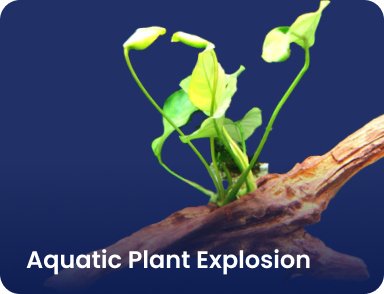

Aquatic Plant Explosion APE is a sustainability project created within the Nano Tanks Australia Brand. It is our hope that with APE we can provide a sustainable, quality products for our customers.
Nano Tanks Australia strives to be an empowering company and the APE Initiative is no different.
In future APE will have it's own YouTube channel and it will be a seperate entity from Nano Tanks Australia. It is the hope that APE will provide essential bunch plants to NTA customers.
Thank you for looking. If there is something you are looking for and it is not present here please let me know and we will try to get it in.

Rotala Blood Red is a variety of Rotala Rotundifolia (also known as Rotala Macrandra) that originates from southeastern China. The leaves are long and narrow, similar to those of Rotala H’ra. Rotala Blood Red is a more demanding type of Rotala and should be grown under high light and with injection of CO2. When grown under these ideal conditions, the leaves will get a striking red color. Iron supplements may help bring out red colors in plants. Rotala Blood Red grows upright, making it ideal for use as a background or midground plant. The bright red color of Rotala Blood Red will catch the eye and bring life to an aquarium. Rotala Blood Red can be grown both submerged and emersed; however, a transition period will be needed if attempting this. To keep Rotala Blood Red from growing too large, trimming should be performed regularly. The trimmed portions can then be rooted and used for further propagation. Notes: Rotala Blood Red is an aquatic plant that can be grown both submerged and emersed. Do not make drastic changes in your aquarium's water parameters or you risk melting the plant. CO2 injection and quality aquarium soil will help your plants thrive and display the best coloration. The final size, coloration and growth rate of Rotala Blood Red are dependent upon the condition of the environment. The picture depicts what you will receive and may vary. To ensure that your plant thrives, research the appropriate care methods. OVERVIEW: Family Name Lythraceae Native Southeastern China Size 4-8inches Ph 6.0-7.5 Temperature 22c - 29 Care Advanced Light High CO2 Required Propagation Herbaceous stem cutting Growth Rate Moderate to Fast
$10.00
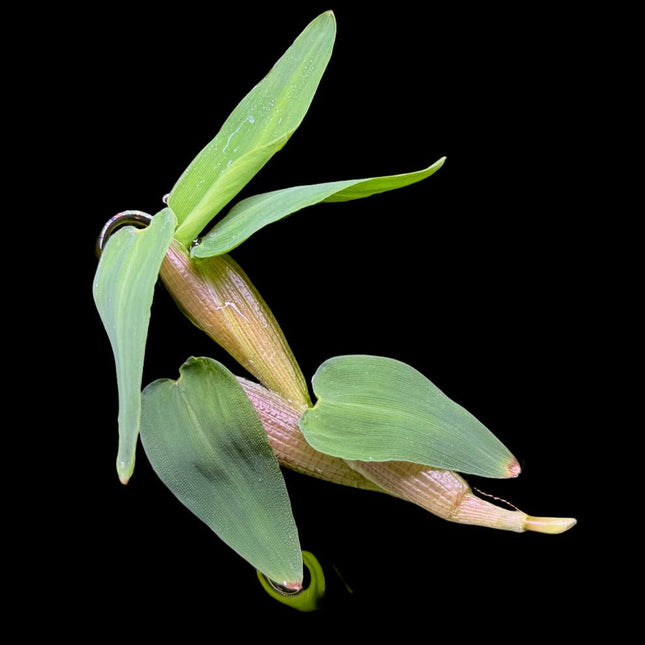
Hygroryza aristata is a unique floating aquatic plant in the Poaceae family. This species is known for its attractive appearance and ability to create a lush, green canopy on the water's surface. Its floating nature and distinctive foliage make it a fascinating addition to any aquarium, providing both aesthetic appeal and functional benefits such as shading and habitat for aquatic life. Key Features: Scientific Name: Hygroryza aristata Common Name: None Family Name: Poaceae Water Parameters: Temperature: 22°C - 28°C pH: 6.0 - 7.5 Hardness: Soft to moderately hard water Light Requirement: Moderate to high lighting Bright light promotes vigorous growth CO2 Requirements: Not necessary Can thrive without CO2 supplementation Plant Appearance: Leaves: Narrow, elongated leaves that float on the water surface, forming dense mats. Growth Habit: Floating stems that spread across the water, providing cover and reducing algae growth by blocking light. Size: Can cover large areas of the water surface, suitable for tanks of various sizes. Care Tips: Regular trimming helps manage its spread and keeps the plant from overcrowding the tank. Thrives in nutrient-rich water, benefiting from regular fertilization. Ideal for providing shade and creating hiding spots for fish and invertebrates. Hygroryza aristata is an exceptional choice for aquarists seeking to add a unique, floating plant to their aquariums. Its ease of care and ecological benefits make it a valuable addition to any aquatic environment. Please note that depending on the season the look of this plant will vary
$8.00

ucephalandra form as "Brownie Purple", however it shows rather brown-green to light reddish tones under water. Its species identity and exact origin are unknown to us; as well as other Bucephalandra, it occurs on rock along fast-flowing rainforest streams on Borneo. The plant is propagated in tissue culture labors (in Vitro). When grown under water, the rhizome is ascending and branched, causing a bushy growth habit. The leaves are about 2-2,5 cm long and 8-9 mm wide, spathulate, with round tip and narrowly wedge-shaped base. They are rosette-like arranged on the stem tips. The plant resembles small forms of Bucephalandra pygmaea. Bucephalandra sp. "Brownie Purple" grows very slowly but has no high demands. It looks best with moderate lighting, good CO2 and nutrient supply and water current. This plant is primarily an epiphyte for the hardscape but can also be fixed to the ground (the rhizome not buried!). It is easily propagated by cuttings of the stem tips and branches. With its bushy look and small, arching leaves, this Bucephalandra is interesting for the planting of the hardscape. It is also small enough to fit into nano aquariums.
$20.00 - $70.00
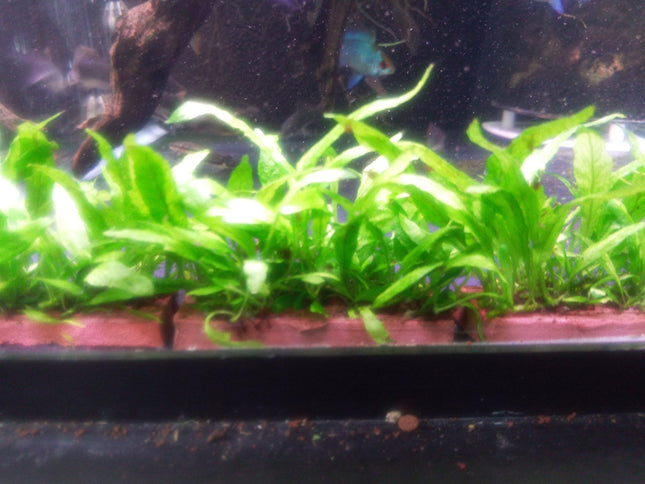
Java-fern-mini is a small, low-maintenance aquatic plant with delicate, bright green leaves. It is a popular choice for aquascaping and aquarists alike due to its low-maintenance nature and its ability to thrive in low-light conditions. It is easy to propagate and can be grown both submerged and emerged, making it a versatile plant for aquariums of all sizes. Its leaves provide a natural filter for the water, removing toxins and pollutants, and its roots help to keep the aquarium substrate clean. This came in a small terracotta pot. It will stay smallish.
$15.00

Windelov Java fern, also known as Microsorum pteropus 'Windelov', is a popular aquatic plant among aquarists due to its ease of care and unique appearance. Its leaves are characterized by small, narrow lobes that create a delicate, lacy effect. Windelov Java fern can be attached to rocks, driftwood, or other aquarium decor, making it a versatile option for aquascaping. It is also known to be hardy and tolerant of a range of water conditions. In addition to its use in aquariums, Windelov Java fern can also be used in terrariums to add a touch of greenery. PLEASE NOTE THAT THIS COMES IN A CLAY POT NOT A PLASTIC POT AS PER THE PICTURE
$19.00

Dwarf Baby Tears (Hemianthus callitrichoides) is a semi-aquatic plant in the Linderniaceae family. It is also known as Water Starwort, and it can be found in the West Indies, including Cuba, Puerto Rico, and The Bahamas. This plant was first collected by Holger Windeløv and Eusebio Canicio Delgado Pérez in 2003 in Las Pozas, Cuba. With its lush green cluster of leaves; sometimes they are mistaken for Monte Carlo when looking at pictures alone. Dwarf Baby Tears Care Dwarf baby tears must be pruned regularly. This is helpful when living in an aquarium with other fish, as dwarf baby tears are typically able to recover from being nipped at. It's best to avoid goldfish, cichlids, or really any larger fish, to help keep a calming environment for your dwarf baby tears. The carpet of green made by the DWARF BABY TEARS cluster leaves provides a great place for aquatic life to leave eggs and start breeding other aquatic life. Dwarf Baby Tears Lighting Aquarium lighting is very important when you consider preparing for dwarf baby tears. You want to make sure not to go above 25° C as higher temperatures have been reported to kill the plants by “melting” or turning the leaves brown. The optimal pH level is anywhere between 6.0-7.5.5. Dwarf baby tears really won’t thrive without light, and lots of it, and a good rule of thumb would be to get yourself a digital thermometer and regularly check the temperature Dwarf Baby Tears CO2 The dwarf baby tears growth process can typically be slow, however, once the bright green leaves blossom they will spread horizontally along the base of your tank, as well as vertically. If you choose to go the CO2 route, which I recommend you do, you may also choose to use an injection of CO2 10-30 mg/l. A nano tank is really the best option, provided that you are able to keep it well-lit and temperature regulated. To have the best success rate, a high-tech tank is the best way to go. Dwarf Baby Tears Carpet Dwarf baby tears will grow throughout your aquarium tank, allowing for other fish to graze and hide their eggs. The importance of high light content and CO2 requirements allows for each portion of the plant to populate and produce stems that can then branch off and begin to grow alongside the aquarium. Is it possible to successfully grow dwarf baby tears on any surface, such as rocks, driftwood, and gravel, but which is the best route to take? It seems to be a matter of preference for most people as any of these will wield the results of carpeting. Growing Dwarf Baby Tears on Driftwood and Rock Driftwood is commonly used with dwarf baby tears, as it can be fairly easy to grow around. Having cracks in the driftwood is also beneficial as it gives the clusters more room to grow and immerse itself within the wood. Some people also chose to use sand as opposed to rocks or gravel, as this is believed to help the roots grow easier and faster. If you start to notice a brown coloring to your green clusters, this is a sign that the leaves are starting to die off. Pruning Dwarf Baby Tears Dwarf baby tears tend to be iron deficient, so they would best thrive off a nutrient rich substrate. Aqua Soil Powder is a great option to use as it is rich in nutrients and minerals that promote healthy growth, while also appearing in a natural earth coloring that looks visually stunning in any aquascape. Dwarf Baby Tears tend to grow into a large carpet at the bottom of your tank. If you start to notice yellowing on your leaves, this is a sign of an iron deficiency and it’s best to act fast and dose it with iron supplements.
$8.00
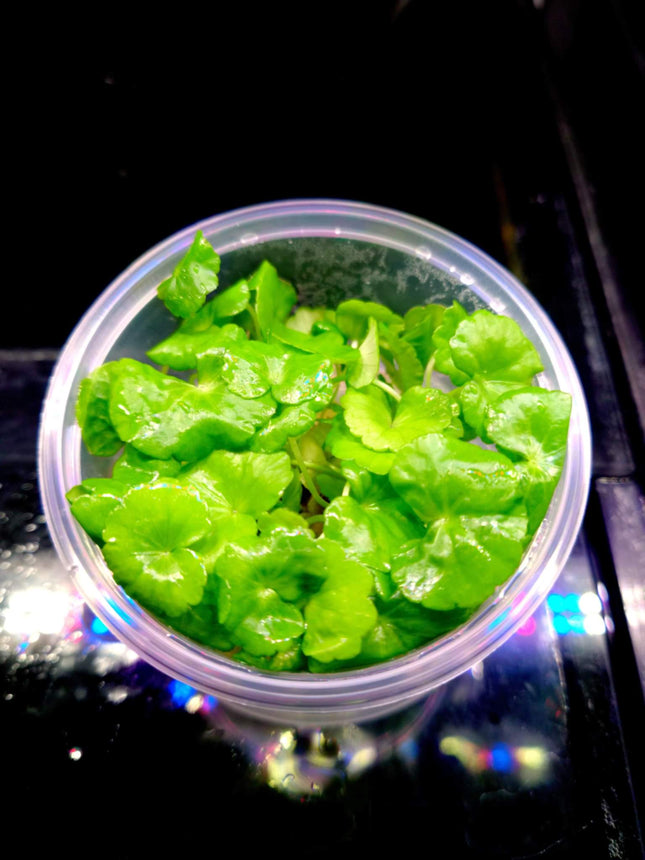
Brazilian Pennywort (Hydrocotyle leucocephala) is a popular stem plant that grows quickly along with runners. Its vibrant green leaves are colored brightly with red and yellow stripes. It also has a similar cousin named Hydrocotyle Verticillata. Hydrocotyle leucocephala is a popular aquarium plant in Asia and is considered an edible plant. It can multiply quickly in the aquarium by planting directly in the substrate or as floating plants. Hydrocotyle leucocephala is an easy-to-grow foreground plant that can be used in the foreground, midground, and background of a tank. It grows best with moderate to high lighting and CO2 injection. By trimming new growth on a regular basis and keeping these plants under control, they can be kept low growing and used to carpet the foreground of your aquarium. Propagate your Hydrocotyle Leucocephala by trimming stems and replanting by pulling apart dense clumps and splitting the roots. The new shoots can be trimmed anywhere along the stem, which allows the plant to grow thicker and more compact. In ideal conditions, the shelf life of Hydrocotyle leucocephala is approximately 4 weeks. Basic care instructions: Do not remove the lid or contamination will occur Keep in well-lit area Storage temperate should not exceed 30°C
$14.95

Description Bacopa Sp. japan (Serpyllifolia ) makes for a perfect mid-ground bush. Likes co2 and regular macro nutrients, good lighting is important or it will melt some at the bottom. Nice shade of green that contrast most mosses and darker green stems. Bacopa Sp. japan likes strong lighting and can melt out at base if not given good light. Bacopa Sp. japan likes good iron and micro fertilisation to really thrive in your aquarium What you get Most of our plants are all aquarium plants, that is when you receive your plants they will have already gone through the transformation process. The transformation the plant has to go through is difficult if all the plants requirements are not met. We do that for you, when you receive your plant it is ready for submersed growing. Submersed growth will look a lot different from the emerged growth, of a terrestrial grown plant. Know what you’re buying, and buy quality. We now have over 350 species growing underwater in our aquariums. Our plants are ready to grow, already transformed aquarium plants. You don’t have to go through the transforming process from terrestrial plants to aquarium plants, we’ve done that for you. Just like fish, live plants do best when they are kept in an aquarium that best suits their needs. Selecting live plants that share common water conditions will minimise problems and make it easier for you to maintain and keep your aquarium in tip top shape. We want your plant to thrive and become a favourite part of your tank. Be sure to choose plants that are suitable for your aquarium so you will get the most out of your new addition. Our plants ship ready to plant in your aquarium. We take great pride in the quality of our plants. Healthy plants ship best.
$10.00

When adding plants to a freshwater aquarium, color and shape are important factors to consider when trying to achieve the most pleasing look. One plant that is both beautiful and relatively simple to maintain is Tiger Lotus or Nymphaea zenkeri. With its broad, wavy-edged leaves and variegated color pattern, it can bring a new and stunning aesthetic to your aquarium. Tiger lotus is a bulb plant that has two types of leaves. The first type consists of completely submersed heart-shaped leaves that grow near the bulb, while the second type has floating leaves on long, thin stems resembling lily pads resting at the surface of the water. How Do You Plant a Tiger Lotus Bulb? To plant a tiger lotus, remove the bulb from its pot and gently rinse off any debris that may be on it. The lotus will grow large, so plant it in the midground or background of your fish tank. Push one-third of the bulb into the substrate so that its shoots or leaves are completely above ground. Do not bury the entire bulb or it will rot; wait for it to become waterlogged enough to sink. As its roots grow into the substrate, they will firmly anchor the bulb in place. How Do You Grow a Tiger Lotus? When your tiger lotus becomes well-established, it'll grow big leaves quickly, so make sure you feed it comprehensive fertilizers like Easy Green and Easy Root Tabs. To bring out the redness in the plant, provide medium to high lighting with some extra iron fertilizer. How Do You Prune an Aquarium Lotus? To trim the lotus plant, simply clip the lily pad at the base of its stem, closest to the bulb. You can also keep the plant from growing too tall by continuously pruning a few of its floating leaves, which allows it to grow out bushier rather than taller.
$35.00

Lobelia cardinalis grows wild in Northern America. In the nursery this plant is cultivated in marshy conditions, forming dark-green leaves which are purple underneath. In aquariums the leaves turn a beautiful shade of light-green, with stems 10-30 cm tall and 5-10 cm wide. Widely used in Dutch aquariums in so-called “plant streets”. In open aquariums it grows above the water surface, where it forms very beautiful scarlet flowers and the leaves regain their colour. Can be used in garden ponds. Plant infoType: StemOrigin: North AmericaGrowth rate: MediumHeight: 20 – 30+Light demand: LowCO2 : Low
$12.00
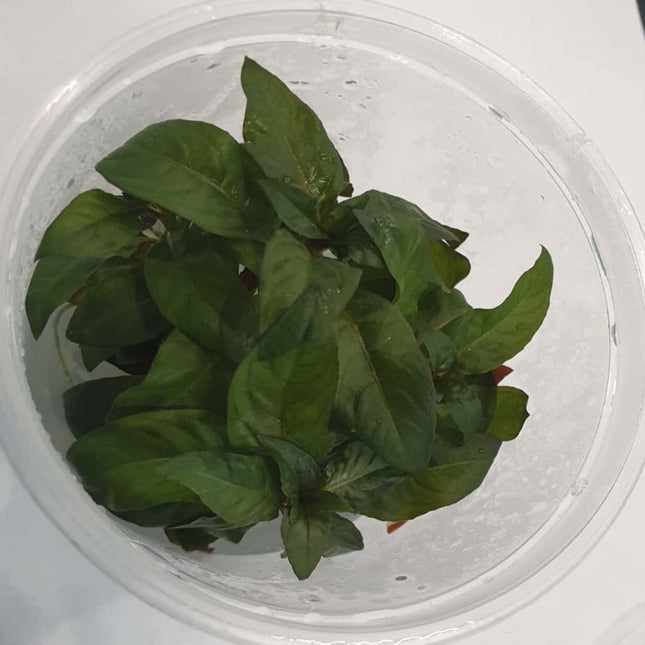
Ludwigia glandulosa from North America is a very beautiful water plant. It is slow growing and requires CO2 addition to grow well. Stems becomes 15-40 cm tall and 5-12 cm wide. The leaves turn greener and the lower ones may fall off if sufficient light is not provided. Used to be sold as Ludwigia perennis. Plant info Type: Stem Origin: North America Growth rate: Medium Height: 15 - 30+cm Light demand: Medium CO2 : Medium
$14.95

As a species of fern, Ceratopteris cornuta is a great choice for beginners as it is low maintenance and easy to grow. With its characteristic layered and feathery leaves, it adds a beautiful natural touch to any aquarium. This plant can also help oxygenate the water and absorb excess nutrients, promoting a healthier aquatic environment.
$14.00

Lilaeopsis pots are a type of aquatic plant pot that is designed to provide a safe and secure environment for plants to grow in. They are made of a plastic mesh material that allows water to flow through it, while keeping the soil and plants contained. The mesh is held together with plastic ties and is designed to be strong and durable. The pots provide a great way to grow aquatic plants, as they allow for plenty of oxygen and water flow and have ample drainage to prevent root rot. They are easy to use and maintain, making them ideal for beginner and experienced aquarists alike
$10.00

Alternanthera Bettzickiana is a popular choice for beginners due to the fact that it's pretty easy to grow. Most red stem plants can prove difficult to get that vibrant red color without providing high CO2 and micronutrients. This plant will keep its vibrant red and pink hues with relative ease, but if nutrients and lighting are severely lacking, the leaves can dull out to an orange hue. It prefers high nitrates and high phosphates so dosing fertilizers such as UNS Plant Food will help speed up growth and keep coloration at its best. A nutrient-rich substrate is necessary when growing this plant. Notes: Alternanthera provides great coverage for sensitive species and are relatively easier choices for beginners who are looking for colored aquarium plants. Do not make drastic changes to the aquarium. Unstable parameters will result in melt and rotting of the aquarium plant. Please be sure to remove this plant from its pot. Remove the cotton surrounding the roots and plant into a quality substrate. For instructions on how to properly prep "potted" aquarium plants, click here. CO2 injection and quality aquarium soil will yield better growth. Please research appropriately to ensure your plant thrives. Family Name: Amaranthaceae Origin: Central/South America Height: 4-12” pH: 6.5-7.5 Care: Easy to Moderate Light: Medium to High Co2: Required Propagation: Cut stem and replant Growth rate: Moderate to Fast
$10.00
![[ARRIVED 5 - JUN - 2025] Bacopa caroliniana 5 stems 10cm tall - Nano Tanks Australia](http://nanotanksaustralia.com.au/cdn/shop/files/arrived-5-jun-2025-bacopa-caroliniana-5-stems-10cm-tall-466097.png?v=1749114201&width=645)
Bacopa Caroliniana – The Hardy & Beginner-Friendly Stem Plant Origin: Native to the United States.Size: Stems grow 10–30 cm long with leaves 3–4 cm wide.Growth Habit: Branches readily from the base, forming lush, bushy clusters. Why Choose Bacopa Caroliniana? ✔ Low Maintenance – Perfect for beginners! Thrives with minimal care.✔ Slow Growth – Unlike fast-growing stems, it won’t overcrowd your tank quickly.✔ Easy Propagation – Simply trim a side shoot and replant into the substrate. Aquascaping Tips 🌿 Plant in small groups for a natural, decorative effect.🌿 Ideal for midground/background in nano or larger tanks.🌿 Versatile – Adapts to a range of lighting and water conditions. A timeless favorite for effortless beauty in planted aquariums!
$10.00 $6.00

This beautiful lace fern is potted in a terracotta pot for a classic look. The lush, lacy leaves offer vibrant texture and lush greenery in any setting. Add an elegant touch to your home with this timeless plant.
$8.00

Syngonium is a genus of tropical and subtropical plants that are popular in the aquarium hobby. The most commonly used species in aquariums is Syngonium podophyllum, which is also known as the Arrowhead plant. In an aquarium, Syngonium plants are typically used for their aesthetic appeal and their ability to absorb excess nutrients from the water, which can help to improve water quality. Syngonium plants are a type of epiphytic plant, which means that they can grow without being rooted in soil. Instead, they can attach themselves to rocks, driftwood, or other decorations in the aquarium. Syngonium plants have heart-shaped leaves that can vary in color, from green to variegated shades of green and white. One of the benefits of using Syngonium plants in an aquarium is their ability to absorb excess nutrients from the water. This can help to reduce the levels of nitrates and phosphates, which can be harmful to fish and other aquatic inhabitants if they are present in high levels. Additionally, Syngonium plants can help to improve water clarity by absorbing particulate matter from the water. Syngonium plants are also popular in aquascaping because of their aesthetic appeal. They can be used to create a natural-looking environment in the aquarium and can add a pop of color to an otherwise dull aquascape. Syngonium plants can be used as a foreground or midground plant, and can be grown both emersed (with their leaves above the water) and submersed (with their leaves below the water). In terms of care, Syngonium plants are relatively easy to grow and require moderate lighting and regular fertilization. They can be propagated by taking stem cuttings and rooting them in the substrate or by attaching them to decorations in the aquarium. Overall, Syngonium plants are a versatile and attractive addition to any aquarium, and can provide both aesthetic and functional benefits.
$14.95

The Ceremic holder is great for java, Christmas or Flame Moss
$9.00
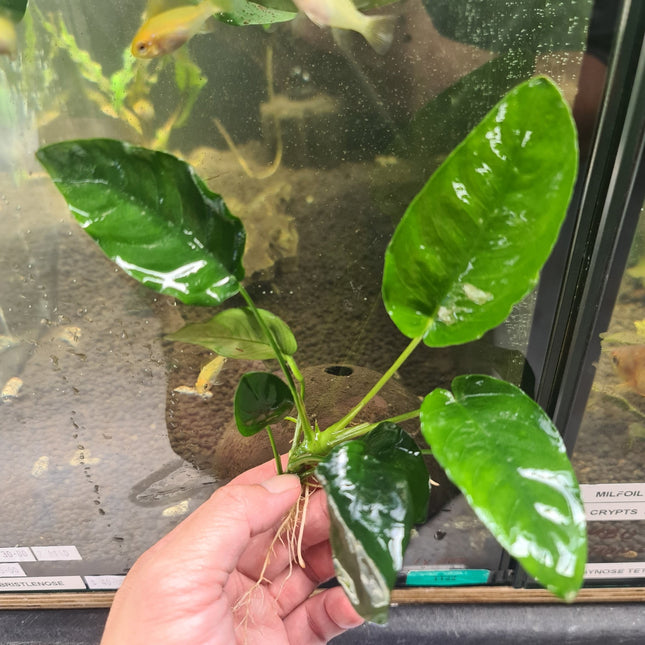
Sold as individual pieces in a terracotta pot The image is an example of the quality you are getting
$25.00
![[ARRIVED 20 - JUN - 2025] Echinodorus Martii bareroot - Nano Tanks Australia](http://nanotanksaustralia.com.au/cdn/shop/files/arrived-20-jun-2025-echinodorus-martii-bareroot-782598.jpg?v=1750749841&width=645)
Description:Echinodorus Martii, commonly known as the Ruffle Sword Plant, is a striking aquatic species prized for its long, wavy-edged leaves that create a dramatic, textured appearance in aquariums. Its bright green, ruffled foliage adds visual interest and serves as an excellent midground to background plant, particularly in larger tanks where it can grow up to 12–24 inches (30–60 cm) tall 147. Key Features: Leaf Structure: Long, thick leaves with ruffled margins and light striations, providing a lush, natural look 14. Growth Habit: Forms a rosette and can produce adventitious shoots (side runners) for propagation 15. Color & Contrast: Its vibrant green hue pairs well with red plants, enhancing aquascape aesthetics 18. Care Requirements: Lighting: Thrives in moderate to high light but adapts to lower light with slower growth 17. Substrate: Requires a nutrient-rich substrate (e.g., enriched soil or root tabs) as it is a heavy root feeder 1411. CO2 & Fertilization: CO2 is optional but boosts growth; benefits from iron and trace elements 47. Water Parameters: Prefers 72–84°F (22–30°C), pH 5.0–7.5, and soft to moderately hard water 711. Propagation & Maintenance: Propagates via side shoots or rhizome division 47. Prune older leaves to control size and encourage new growth 15. Ideal For: Beginners due to its hardiness 13. Centerpiece or background in mid-to-large tanks 28. Origin: Native to Central and South America, often found in submerged riverbanks 15. Note: Some taxonomists classify E. martii as synonymous with E. major or E. subalatus, but it remains a trade staple under its common name 5.
$20.00

Assorted Buce on a piece is a unique, eye-catching design that is perfect for any aquarium. This pattern features a variety of different sized and shaped Buce in a range of green and brown colors. This is usually attached to a stone or a rock
$39.95

Java Fern on Mopani is a type of aquatic plant known for its hardy and resilient nature. It is native to the tropical areas of South and Southeast Asia, and is a popular choice for aquariums. The Mopani wood provides a natural substrate for the Java Fern, allowing it to attach its roots directly to the wood. It has lush, green foliage with pointed leaves which can reach up to 10 inches in length. The rhizomes of this fern can spread quickly, creating a dense carpet of foliage. The plant thrives in medium to low light and needs to be fertilized regularly. It also prefers a low pH and soft water, so the tank must be regularly monitored to ensure the water and light conditions are optimal. Java Fern on Mopani is an excellent choice for any aquarium and can bring a unique and exotic look to any underwater landscape.
$14.95

Ludwigia sp. 'Super Red' is a new Ludwigia species that assumes an intensively red color even under medium light. It ramifies well and is rather undemanding. It was brought onto the market under several names. This plant look similar to Ludwigia "Rubin" that develops larger leaves, the different between Ludwigia sp. 'Super Red' and Ludwigia Rubin is Ludwigia sp. 'Super Red' has thinner leaves. Ludwigia sp. 'Super Red' will do best in rich nutrient substrate, high lighting and CO2 injected aquarium.
$10.00

Fissidens moss, also known as aquatic moss or aquarium plant, is a versatile and visually appealing addition to any aquatic landscape. With its fern-like appearance and vibrant green color, it adds a natural and authentic touch to aquariums, aquascapes, and other aquatic environments. One of the great benefits of Fissidens moss is that it's relatively easy to care for. It thrives in low to medium light and can be grown on various surfaces such as rocks, driftwood, or substrate. This makes it an excellent choice for beginners or those who want to add a low-maintenance plant to their aquarium. Not only is Fissidens moss visually pleasing, but it also provides several benefits to its environment. It helps filter water, absorb excess nutrients, and provide oxygen to the surrounding aquatic life. Moreover, Fissidens moss is a natural habitat for many aquatic animals such as shrimps and snails, creating a harmonious ecosystem. If you're looking for an eye-catching and easy-to-care-for addition to your aquatic landscape, Fissidens moss is an excellent choice. Its aesthetic and functional benefits make it a popular choice among aquarium enthusiasts and landscape designers alike. So why not add this beautiful aquatic moss to your collection today? Portion Size: 5x5cm when laid out flat which equates to 2-2.5 grams weight (without excess water)
$20.00
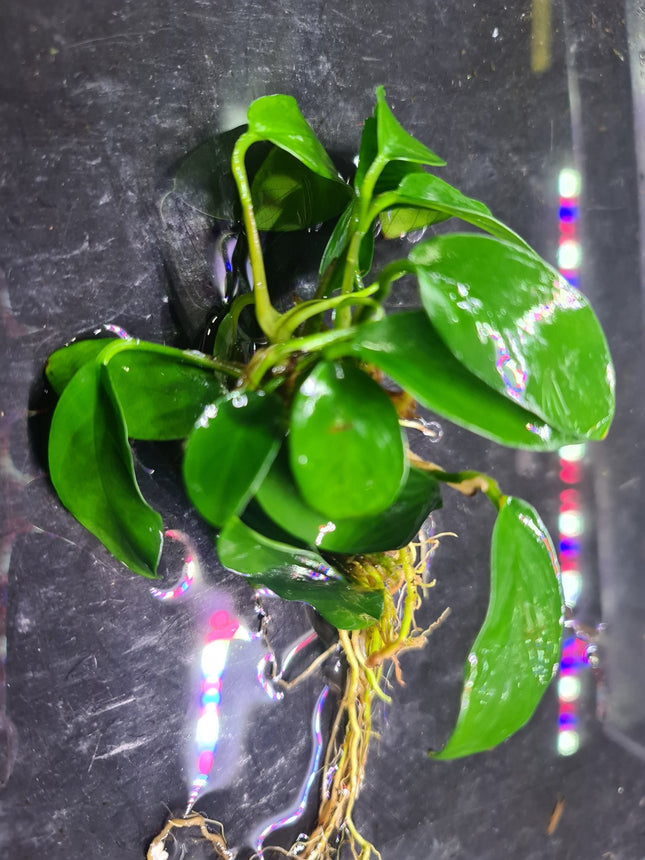
Sold as individual pieces. The image is an example of the quality you are getting Most of what is being sold are: Anubias Barteri Anubias Hastifolia Anubias Nana This is random and there is no choice on which plant you will get unless you are in the shop picking it out yourself
$20.00

Microsorum pteropus or Java fern is from Asia. Microsorum pteropus ‘Trident’ is a narrow-leaved, smaller form of Microsorum, which like other Microsorum is an easy and safe plant. ’Trident’ is both suitable for beginners, as well as the experienced scaper, and fits both smaller and larger aquariums. The name ’Trident’ tells that the plant leafs are tripartite, while the leaves can vary from whole to multipartite. Suitable for planting on stones or tree roots. When planted on the bottom layer, avoid covering the horizontal stalk. New, small plants are often created on the leaf tips, and can carefully be pulled off and planted.
$40.00

$15.00

This neat Bucephalandra form is not yet determined to species. However, its trading name seems to indicate that it originates from the Batang Kawa district in Central Kalimantan. Bucephalandra species occur on rock in the flood zone of fast-flowing rainforest streams on Borneo island. Bucephalandra sp. "Batang Kawa" resembles the "Brownie" forms. It has elliptic leaves with wavy edge. Young leaves and rhizoms show brown-red tones. Generally, Bucephalandras grow very slowly. They cope with little light but look best with moderate lighting, good CO2 and nutrient supply and water current. They are primarily epiphytes for the hardscape that attach themselves to rock and wood, but they can also be fixed to the ground (the rhizome not buried!) where they will take root. The propagation is easy by cuttings of the stem tips and branches. With its bushy look, this Bucephalandra is interesting for the planting of the hardscape. It is also small enough to fit into nano aquariums.
$150.00

This unique form of Lagenandra meeboldii has an eye-catching almost black stripe pattern on a purplish red background. It was found in 2009 by a team from Sreepadma company in the Wayanad region of Kerala and propagated through tissue culture. Younger plants initially form olive-green to red-brown leaves for a longer time, similar to L. meeboldii "Red". The striking leaf markings only appear on mature, older plants. These have in the submerged form about 10 cm long, 4.8 cm wide ovate leaf blades on 10 cm long petioles. The plant grows to at least 15 cm high and forms a thick, creeping rhizome.The variable species Lagenandra meeboldii from south-western India is an amphibious plant that can grow above and below water. In nature, it grows on shady, swampy, intermittently flooded stream banks. Lagenandra species prefer a nutrient-rich substrate and tropical temperatures between about 22 and 28 °C. CO2 addition is recommendable, moderate lighting is sufficient. The growth is rather slow. In contrast to most Cryptocoryne, Lagenandra meeboldii does not form underground runners but a thick rhizome that can be split for propagation. With its pretty pattern on the leaves, Lagenandra meeboldii 'Bleeding Heart' attracts attention as a solitary or group plant that is best placed in the aquarium midground. It is also recommended for emersed setups where one may expect its striking inflorescences.
$20.00 - $60.00
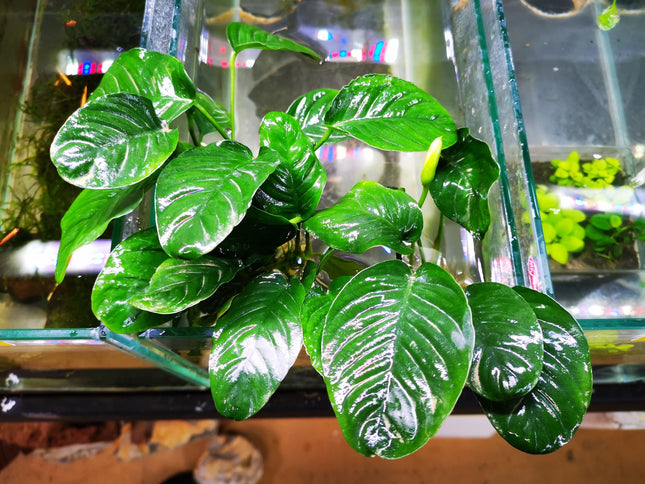
Anubias-jenny is a unique aquatic plant with a unique look. It has beautiful, bright green leaves that are thick and leathery. The leaves grow in a rosette pattern, and they taper to a point. The leaves are also marked with random streaks of white, which makes them stand out from other aquatic plants. Anubias-jenny is also very hardy and can tolerate a wide range of water conditions, making it a great choice for beginner aquarists. It's a slow-growing plant, and it prefers low to moderate lighting. In addition to being an attractive plant, Anubias-jenny also provides a great hiding spot for fish and shrimp.
$49.00

Pink Baby Tears have small, delicate leaves that will cascade down and look beautiful in any setting. The stems measure about 10cm in length, and each stem has a few leaves and small flowers. These plants are low light, low maintenance, and an ideal addition to any terrarium or fairy garden.
$10.00

Limnophila Aromatica Limnophila Aromatica is a beautiful plant perennial plant that can display a wide array of different colors ranging from green to red to pink. The thin and pointy leaves grow in opposite pairs along the whole length of the stem. If pruned frequently, this plant will branch out and provide a bushy filler for the mid- or background of your tank. This is an easy plant but to get the desirable bright red color, you must provide high lighting and nutrient levels. High iron content will bring out more red tones in the plant. CO2 injection is not required for the cultivation of this plant, but can help it grow more robustly. The plant can be grown submersed or emersed. Propagation can be achieved by taking cuttings from the main stem of the plant that are replanted into the substrate. Family Name: Plantaganaceae Origin: South East Asia Height: 8-20” pH: 6.5-7.5 Care: Easy Light: Moderate to High Co2: Required Propagation: Cuttings Growth Rate: Medium
$6.00

Ludwigia Glandulosa Scientific name: Ludwigia glandulosa Family: Onagraceae Usual maximum size in aquariums: 15 - 40 cm (5.91 - 15.75 inch) Recommended pH range for the species: 6 - 7.2 Recommended water hardness (dGH): 4 - 12°N (71.43 - 214.29ppm) Recommended temperature: 20 - 28 °C (68 - 82.4°F) Reproduction of the plant: Cuttings Origin (in the wild): North America How fast these plants grow: Slow Recommended substrate: Fine gravel Demands on lighting: Bright Ideal placement in a fish tank: Background
$9.95

Plant info Type: Stem Origin: Cultivar Growth rate: High Height: 3 - 10+ Light demand: Low CO2 : Low This plant has been used as a medicine for humans but in the fish tank it can be kept within the aquarium or as an immersed plant The plant itself has a pleasant smell and has nice blue flowers during spring. This is also the Tissue Cultured variety and due to that there are no issues with algae or snail introductions
$14.95

The Trident Fern on Wood is a unique, tropical plant that adds a touch of the exotic to any home. With its bright green, frond-like foliage and its unique trident-shaped leaves, this plant adds a unique twist to any home décor. Its woody stem is the perfect complement to the vibrant green of the foliage, giving it a natural, rustic look. It is a great option for both indoor and outdoor spaces, and is sure to draw attention and admiration.
$65.00

Heteranthera zosterifolia from South America is an extremely beautiful plant, which forms a lot of side shoots and thus quickly forms a bushy plant group. Stems can become 30-50 cm tall and 6-12 cm wide. Leaves often become black on the back. In strong light growth is intensive, and the plant must be pruned before it becomes so compact that no light reaches the lower leaves. Water roots often form on the stem. Those are easily cut and replanted. In open aquariums, it forms small blue flowers if some shoots are allowed to spread on the surface. Type: Stem Origin: South America Growth rate: High Light demand:Low CO2 : Medium
$9.95
You have seen 72 out of 122 products